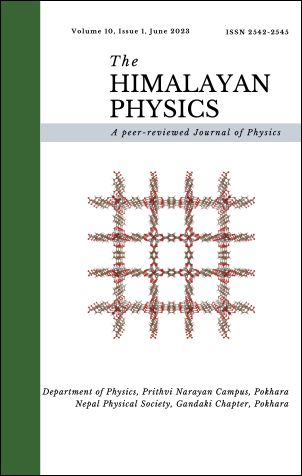Comparative study of solar flux using different empirical models at low land urban industrial zone of Biratnagar Nepal
DOI:
https://doi.org/10.3126/hp.v10i1.55286Abstract
Nepal is a developing country where sufficient clean energy is not available in our daily needs for cooking, lighting and other developmental activities. So, it is high time to promote clean and green energy, which is freely available in every corner of the country. In this regard, the present study helps to estimate the global solar radiation at the lowland region Biratnagar (lat. 26◦28′53′′N, long. 87◦15′50′′E and Alt. 72 m) using measured global solar radiation (GSR) and sunshine hours on empirical models. This paper uses the regression technique on two different empirical models Angstrom-Prescott(A-P) and Tiwari and Sangeeta, to estimate solar radiation. After analyzing the data on empirical models, the empirical constants 0.25 and 0.23 and 0.13 and 0.24 are found in A-P and Tiwari and Sangeeta models, respectively. The performance of the models was carried out by employing mean bias error (MBE), mean percentage error (MPE), root mean square error (RMSE) and adjusted coefficient of determination (R2). These statistical tools reveal that all these models are statistically significant. Such a study is relevant when reliable data for solar radiation is not adequately available. The findings of empirical coefficients can be utilized for predicting solar radiation and solar energy at similar geographical locations in Nepal.
Downloads
Downloads
Published
How to Cite
Issue
Section
License
This license enables reusers to distribute, remix, adapt, and build upon the material in any medium or format for noncommercial purposes only, and only so long as attribution is given to the creator. If you remix, adapt, or build upon the material, you must license the modified material under identical terms.




